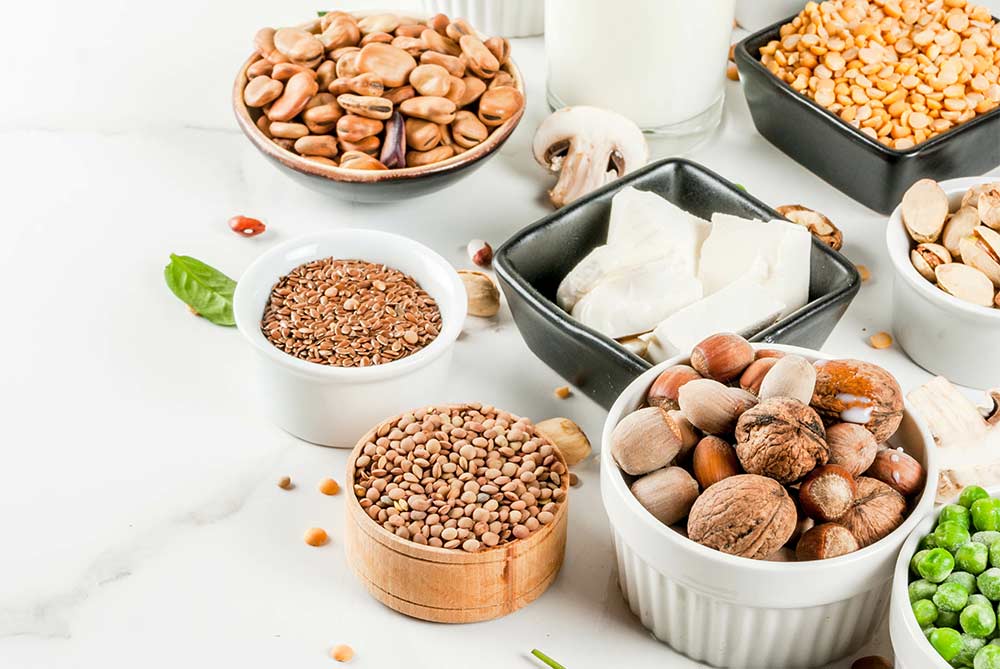3 Ahnen, R. T., Jonnalagadda, S. S., & Slavin, J. L. (2019). Role of plant protein in nutrition, wellness, and health. Nutrition Reviews, 77(11), pp. 735–747. doi:10.1093/nutrit/nuz028
4 Melina, V., Craig, W., & Levin, S. (2016). Position of the Academy of Nutrition and Dietetics: Vegetarian Diets. Journal of the Academy of Nutrition and Dietetics, 116(12), pp. 1970–1980. doi:10.1016/j.jand.2016.09.025
5 Curtain, F., & Grafenauer, S. (2019). Plant-Based Meat Substitutes in the Flexitarian Age: An Audit of Products on Supermarket Shelves. Nutrients, 11(11), p. 2603. doi:10.3390/nu11112603
6 Yu, Y.-M., & Fukagawa, N. K. (2020). Chapter 2 – Protein and amino acids. In B. P. Marriott, D. F. Birt, V. A. Stallings, & A. A. Yates, Present Knowledge in Nutrition (Eleventh Edition) (pp. 15-35). Academic Press. doi:10.1016/B978-0-323-66162-1.00002-0
7 Mittendorfer, B., Klein, S., & Fontana, L. (2020). A word of caution against excessive protein intake. Nature Reviews Endocrinology, 16(1), pp. 59–66. doi:10.1038/s41574-019-0274-7
8 Hamdy, O., Ganda, O. P., Maryniuk, M., Gabbay, R. A., & Members of the Joslin Clinical Oversight Committee. (n.d.). CHAPTER 2. Clinical nutrition guideline for overweight and obese adults with type 2 diabetes (T2D) or prediabetes, or those at high risk for developing T2D. The American Journal of Managed Care, 24(7), pp. SP226–SP231. Retrieved from https://www.ajmc.com/view/presentation-outlines-long-term-cv-risks-of-gestational-diabetes
9 Drummen, M., Tischmann, L., Gatta-Cherifi, B., Adam, T., & Westerterp-Plantenga, M. (2018). Dietary Protein and Energy Balance in Relation to Obesity and Co-morbidities. Frontiers in Endocrinology, 9(Art. 443). doi:10.3389/fendo.2018.00443
10 Joint FAO/WHO/UNU Expert Consultation on Protein and Amino Acid Requirements in Human Nutrition. (2007). Protein and amino acid requirements in human nutrition : report of a joint FAO/WHO/UNU expert consultation. Geneva. Retrieved from https://apps.who.int/iris/handle/10665/43411?search-result=true&query=Protein+and+amino+acid+requirements&scope=&rpp=10&sort_by=score&order=desc
11 European Food Safety Authority. (2012). Scientific Opinion on Dietary Reference Values for protein. EFSA Journal, 10(2), p. 2557. doi:10.2903/j.efsa.2012.2557
12 U.S. Department of Health and Human Services and U.S. Department of Agriculture. (2020). Dietary Guidelines for Americans, 2020-2025. 9th Edition. Retrieved July 2021, from https://www.dietaryguidelines.gov/resources/2020-2025-dietary-guidelines-online-materials
13 Ministry of Health, Labour and Welfare, Government of Japan. (2020). Dietary Reference Intakes for Japanese (2020): Report of the Study Group on the Dietary Reference Intakes for Japanese People (日本人の食事摂取基準(2020 年版): 「日本人の食事摂取基準」策定検討会報告書). Retrieved from https://www.mhlw.go.jp/stf/newpage_08517.html
14 National Health Commission of the People’s Republic of China. (2017). Dietary Reference Intakes for Chinese Residents, Part 1: Macronutrients (中国居民膳食营养素参考摄入量第1部分:宏量营养素). Retrieved from http://www.nhc.gov.cn/wjw/yingyang/201710/fdade20feb8144ba921b412944ffb779.shtml
15 Health Promotion Administration, Taiwan Ministry of Health and Welfare. (2020). Dietary Reference Intakes Eighth Edition: Macronutrients Protein and lipid chapter (draft) revision (「國人膳食營養素參考攝取量」第八版-巨量營養素: 蛋白質及脂質章節(草案)增修訂 線上說明會之重點紀要). Retrieved September 2021, from https://health99.hpa.gov.tw/
16 Agnoli, C., Baroni, L., Bertini, I., Ciappellano, S., Fabbri, A., Papa, M., Pellegrini, N., Sbarbati, R., Scarino, M. L., Siani, V., & Sieri, S. (2017). Position paper on vegetarian diets from the working group of the Italian Society of Human Nutrition. Nutrition, Metabolism, and Cardiovascular Diseases, 27(12), pp. 1037–1052. doi:10.1016/j.numecd.2017.10.020
17 Jäger, R., Kerksick, C. M., Campbell, B. I., Cribb, P. J., Wells, S. D., Skwiat, T. M., Purpura, M., Ziegenfuss, T. N., Ferrando, A. A., Arent, S. M., Smith-Ryan, A. E., Stout, J. R., Arciero, P. J., Ormsbee, M. J., Taylor, L. W., … Antonio, J. (2017). International Society of Sports Nutrition Position Stand: protein and exercise. Journal of the International Society of Sports Nutrition, 14(Art. 20). doi:10.1186/s12970-017-0177-8
18 Evert, A. B., Dennison, M., Gardner, C. D., Garvey, W. T., Lau, K., MacLeod, J., Mitri, J., Pereira, R. F., Rawlings, K., Robinson, S., Saslow, L., Uelmen, S., Urbanski, P. B., & Yancy, W. S. (2019). Nutrition Therapy for Adults With Diabetes or Prediabetes: A Consensus Report. Diabetes Care, 42(5), pp. 731–754. doi:10.2337/dci19-0014
19 Agence nationale de sécurité sanitaire de l’alimentation, de l’environnement et du travail (Anses), France. (2020). Ciqual – Table de composition nutritionnelle des aliments: Protéines, N x 6.25 (g/100 g). Retrieved September 2021, from https://ciqual.anses.fr/
20 European Consumer Organisation (BEUC). (2020). One bite at a time: Consumers and the transition to sustainable food. Brussels: BEUC. Retrieved from https://www.beuc.eu/publications/most-eu-consumers-open-eat-more-sustainably-face-hurdles-new-survey-shows/html
21 European Parliament & Council of the European Union. (2006). Regulation (EC) n°1924/2006 of the European Parliament and of the Council of 20 December 2006 on nutrition and health claims made on foods (consolidated version: 2014). Official Journal of the European Union, L 404, 9-25.
22 Food and Agriculture Organization of the United Nations & World Health Organization. (1997). CAC/GL 23-1997: Guidelines for use of nutrition and health claims (last updated: 2013). Codex Alimentarius, pp. 1-8. Retrieved from http://www.fao.org/fao-who-codexalimentarius/codex-texts/guidelines/en/
23 Consumer Affairs Agency of Japan. (2013). Food Labelling Act (Act n°70) (食品表示法 (平成二十五年法律第七十号)) (last updated: 2019). Retrieved from https://elaws.e-gov.go.jp/document?lawid=427M60000002010
24 Ministry of Health of the People’s Republic of China. (2011). National Standards of the People’s Republic of China GB 28050-2011: Standard for nutrition labelling of prepackaged foods (食品安全国家标准 预包装食品营养标签通则).
Show Less

